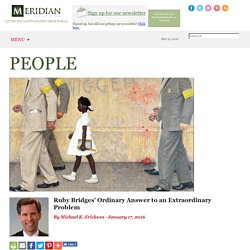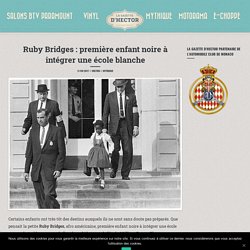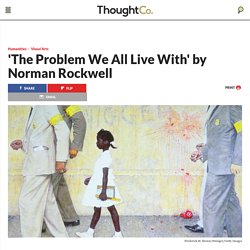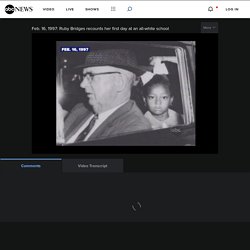

Ruby Bridges discusses 3rd book 'This Is Your Time' Tim Allen’s beard is growing, which means Santa’s on his way00:50Michael J.

Charlotte.siess - Yahoo Mail. Charlotte.siess - Yahoo Mail. Biography of Norman Rockwell, American Painter. Ruby Bridges' Ordinary Answer to an Extraordinary Problem. To sign up for Meridian’s Free Newsletter, please CLICK HERE.

A shorter version of this article appeared in the Deseret News today. Norman Rockwell had extraordinary talent for painting the ordinary moments of American life. Many of his best-loved works are currently on display at the BYU Museum of Art through February 13th. As the exhibit’s title “American Chronicles” suggests, the collection is a window into America’s past, even more specifically Americans’ past. Ruby Bridges : première enfant noire à intégrer une école blanche - La gazette d'Hector La gazette d'Hector. Certains enfants ont très tôt des destins auxquels ils ne sont sans doute pas préparés.

Que pensait la petite Ruby Bridges, afro américaine, première enfant noire à intégrer une école pour enfants blancs, quand elle a franchi la porte de l’école William Frantz Elementary school en Louisiane ? Nous sommes le 14 novembre 1960. Voici son histoire. Ruby Bridges Hall est née le 8 septembre 1954 à Tylertown dans le Mississippi.
Ruby Bridges. Nov. 14, 1960 - Ruby Bridges, Age 6, Integrates New Orleans School. A Look at Rockwell's "The Problem We All Live With" On November 14, 1960, six-year-old Ruby Bridges attended William J.

Frantz Elementary School in the 9th Ward of New Orleans. It was her first day of school, as well as New Orleans' court-ordered first day of integrated schools. If you weren't around in the late '50s and early '60s, it may be difficult to imagine just how contentious was the issue of desegregation. A great many people were violently opposed to it. Hateful, shameful things were said and done in protest. Ku Klux Klan - Students. A secret American terrorist organization, the Ku Klux Klan led underground resistance against the civil rights and political power of newly freed black slaves during the Reconstruction period after the American Civil War.

The Klan’s goal was to reestablish the dominance of the prewar plantation aristocracy. It was revived in an altered form in the 20th century. Organized in 1866 by Confederate veterans as a social club in Pulaski, Tennessee, the Ku Klux Klan was restructured along political and racial lines a year later in Nashville, Tennessee. Sometimes called the Invisible Empire of the South, the KKK, or the Klan, it was presided over by a grand wizard and a descending hierarchy of grand dragons, grand titans, and grand cyclopses.
Ku Klux Klan. The Ku Klux Klan (KKK) is one of several white supremacy organizations in the United States, which are dedicated to opposing civil rights for Blacks, Jews, and other ethnic, racial, social or religious groups.

They also oppose Catholicism, and 'left' groups such as the IWW, and the gay rights movement. The KKK, a brief summary. by Michael Mulderig on Prezi. Top 5 Questions About the KKK. American Experience asked sociologist and Ku Klux Klan scholar David Cunningham to provide responses to the five questions he is most frequently asked about the Klan.

The author of Klansville, U.S.A.: The Rise and Fall of the Civil Rights-Era KKK (Oxford University Press, 2013), Cunningham is Professor and Chair of Sociology at Brandeis University. Before discussing the most pressing questions people tend to have about the KKK, let me add some background for basic context. The Ku Klux Klan was first formed in 1866, through the efforts of a small band of Confederate veterans in Tennessee. Quickly expanding from a localized membership, the KKK has become perhaps the most resonant representation of white supremacy and racial terror in the U.S. The AMERICAN EXPERIENCE documentary Klansville, U.S.A. focuses on the civil rights-era KKK and tells the story of Bob Jones, the most successful Klan organizer since World War II. 1.
I might add two caveats to that reassuring portrait, however. 2. Ku Klux Klan. Nov. 9, 1978: Norman Rockwell Dies Video. What are Norman Rockwell’s best works? Sunday marks what would have been Norman Rockwell’s 125th birthday.

Rockwell gained fame throughout the 20th century as a remarkable illustrator who captured the essence of everyday life in America. He was raised in the art scene of New York City and found success as a commercial artist early in life. The Tragic Death of Norman Rockwell. Norman Rockwell - A brief biography - A career in illustration.
Image Credits: Norman Rockwell (1894-1978), Before the Shot, 1958. Cover illustration for The Saturday Evening Post, March 15, 1958. From the collection of Norman Rockwell Museum. © 1958 SEPS: Curtis Licensing, Indianapolis, IN. All rights reserved. Norman Rockwell (1894-1978), Willie Gillis: USO, 1942. Norman Rockwell. Analysing_painting. The problem we all live with Worksheet Colette Alloing. Rockwell – The problem we all live with. ART DU VISUEL DU XXème siècle.

"The Problem we all live with" de Norman Rockwell. Painting Tour: "The Problem We All Live With" (1964) Feb. 16, 1997: Ruby Bridges recounts her first day at an all-white school Video. Feb. 16, 1997: Ruby Bridges recounts her first day at an all-white school Facebook Twitter Email Embed.

MLK Day Legacy: Ruby Bridges. Freedoms's Legacy: A Conversation with Ruby Bridges Hall. Ruby Bridges interview. We Are All Going Against The Grain. HDA activity 2. 14th November 1960: Ruby Bridges, the first African-American to desegregate an elementary school. The problem we all live with. The Problem We All Live With_Norman ROCKWELL.
(repris du site du Collège Marcel Proust) ici Dans le cadre de l'épreuve d'histoire des arts, les élèves de 3ème ont la possibilité de présenter un tableau de Norman Rockwell que voici: The Problem We All Live With by Norman Rockwell (1964). Si vous choisissez cette œuvre pour l'oral de l'histoire des arts, vous devrez montrer au jury que vous connaissez le tableau, son contexte historique et que vous savez aussi aborder d’autres œuvres qui traitent de ce sujet. Il faudra restituer en français les connaissances que vous avez apprises en anglais. Vérifiez donc que vous connaissez bien la signification de chaque mot important dans ta propre langue ! I- Présentation de l’œuvre NB: Ces éléments ne sont que des rappels.
A) Introduction Il s’agit de présenter le tableau et son thème : Qui : Tableau de Norman Rockwell, illustrateur et peintre américain (précise ses dates de naissance et décès, son parcours, ses autres œuvres connues, comme son travail au Post – recherche à faire). Norman Rockwell's "The Problem We All Live With" To Be Exhibited at The White House - Norman Rockwell Museum - The Home for American Illustration.
“I was about 18 or 19 years old the first time that I actually saw it,” says Ruby Bridges Hall, who now serves on the board of Norman Rockwell Museum. “It confirmed what I had been thinking all along–that this was very important and you did this, and it should be talked about… At that point in time that’s what the country was going through, and here was a man who had been doing lots of work–painting family images–and all of the sudden decided this is what I am going to do… it’s wrong and I’m going to say that it’s wrong.” The illustration appeared in the January 14, 1964 issue of “Look” magazine, and earned Rockwell letters of both praise and criticism from readers unused to such direct social commentary from the illustrator.
Ms. Projet art et epoque. Draw my life - Ruby de The Problem we all live with - ARTE. Hda doc. The Problem We All Live With. The problem we all live with.